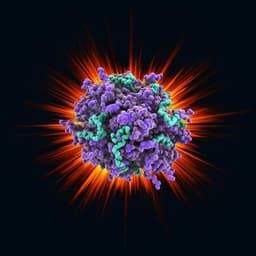
Physics
Nondestructive ultrafast steering of a magnetic vortex by terahertz pulses
D. Yu, J. Kang, et al.
This groundbreaking research by Dongxing Yu, Jiyong Kang, Jamal Berakdar, and Chenglong Jia unveils a new method for controlling magnetic vortex dynamics using ultrafast electrical pulses. By harnessing skyrmion-mediated vortex switching, the team demonstrates a highly efficient technique for nonvolatile magnetic information storage, revolutionizing spintronic devices.
~3 min • Beginner • English
Introduction
Magnetic vortices in confined soft ferromagnets (e.g., disks, triangles, squares, stripes) are topological spin textures characterized by an in-plane curling magnetization (chirality: clockwise or counterclockwise) and a nanometer-scale out-of-plane core magnetization (polarity: up or down). They are attractive for spintronic applications due to high thermal stability, weak magnetostatic interactions, and multistate information capacity. However, due to rotational symmetry and strong exchange interactions, reliably reversing vortex polarity and especially chirality is difficult. Prior approaches using magnetic fields, spin-polarized currents, spin waves, or laser pulses have not provided reproducible control; in particular, chirality switching often occurs stochastically. This work addresses whether time-asymmetric terahertz (THz) electric-field pulses, via magnetoelectric (ME) coupling arising from the inverse Dzyaloshinskii–Moriya mechanism, can provide ultrafast, noninvasive, and reproducible electric control of both vortex polarity and chirality. The study demonstrates that packaged-skyrmion-mediated dynamics enables deterministic, repeatable switching between four vortex states on picosecond time scales, offering a pathway to energy-efficient vortex-based information technologies.
Literature Review
Previous vortex-core polarity switching has been achieved using alternating magnetic fields, in-plane magnetic field pulses, resonant microwave pulses, field-driven spin waves, spin-polarized currents, and photothermal-assisted femtosecond laser pulses. Chirality control with magnetic fields typically requires structural asymmetry (e.g., broken-symmetry geometries), and simultaneous control of chirality and polarity has been challenging, with core switching times hard to pinpoint and chirality emerging randomly with similar frequencies for clockwise and counterclockwise states. To advance ultrafast all-optical magnetism, the magnetoelectric effect based on the inverse Dzyaloshinskii–Moriya mechanism provides a means for electric fields to couple to noncollinear spin textures. Recent developments in strong, time-asymmetric THz sources motivate exploring purely electric-field-driven switching leveraging ME coupling.
Methodology
The dynamics were studied via finite-difference micromagnetic simulations with GPU acceleration, solving the Landau–Lifshitz–Gilbert equation. The effective magnetic field included exchange, uniaxial magnetocrystalline anisotropy, demagnetizing fields, and a magnetoelectric (ME) effective field H_me derived from the inverse Dzyaloshinskii–Moriya mechanism, allowing electric-field coupling to noncollinear spin textures. Material parameters correspond to permalloy (Py) at room temperature: exchange A = 13 pJ/m, saturation magnetization M_s = 8 × 10^5 A/m, uniaxial anisotropy K_u = 0, and Gilbert damping α = 0.05. The ME coupling constant ξ_m = 1 pC/m (representative for Py on Pt) was used. The simulated element was a Py square of width 99 nm and thickness 3 nm, discretized into (3 nm)^3 cells. The initial state was a stable magnetic vortex with polarity p = +1 and chirality c = +1. Electric-field drive consisted of experimentally feasible time-asymmetric half-cycle pulses (HCPs) with a strong, short head and a weaker, longer tail; the pulse time integral is zero. Maxwell simulations of the field distribution confirmed that for the geometries, sizes, and intensities used, coupled Maxwell–micromagnetic simulations were unnecessary. Static, spatially inhomogeneous Gaussian electric fields along z were also applied to map phase diagrams of remanent states and to characterize emergent topological textures via skyrmion number s and chirality number c. For polarity reversal, a representative HCP used a 50 MV/cm, 15 ps head followed by a 5 MV/cm, 150 ps tail (k = 6). For chirality-only reversal, a weaker, longer HCP with a 10 MV/cm, 450 ps head and 2.5 MV/cm, 1800 ps tail (small k) was used. Simultaneous polarity and chirality reversal was achieved by slightly shortening the pulse duration relative to the chirality-only case to interrupt relaxation pathways. Switching sequences between arbitrary pairs of vortex states employed appropriate combinations of these pulses with a 42.5 ps inter-pulse interval for stability.
Key Findings
- Deterministic, reproducible electric-field control of a magnetic vortex using time-asymmetric THz pulses via magnetoelectric coupling was achieved in simulation, enabling repeated switching among four vortex states (I→II→III→IV→I...).
- Ultrafast speeds: vortex-core polarity reversal occurs in ~15 ps; chirality reversal in ~325 ps, both faster than previously reported methods.
- Discovery of packaged-skyrmion-mediated switching: the polarity switching proceeds through the transient formation of a localized packaged skyrmion carrying skyrmion number s = ±1, enabling a change Δs = ±1 between vortex states without creating/annihilating a vortex–antivortex pair (non-gyrotropic mechanism).
- Polarity-only reversal: using a 50 MV/cm, 15 ps head and 5 MV/cm, 150 ps tail HCP induces a transient packaged skyrmion that decays into the opposite-polarity vortex with high reproducibility.
- Chirality-only reversal: a 10 MV/cm, 450 ps head and 2.5 MV/cm, 1800 ps tail HCP creates a transient hedgehog (Néel-type) skyrmion (s ≈ 1 around 190 ps) that relaxes to a vortex with reversed chirality (state III), robustly surviving the pulse tail.
- Simultaneous reversal of polarity and chirality: slightly shorter pulse duration prevents relaxation to the intermediate chirality-reversed state, leading to stabilization of state II with both polarity and chirality reversed.
- Phase diagrams under static Gaussian fields reveal, in addition to the four vortex states, packaged-skyrmion-like stable configurations (V–VIII) with localized topological charge |s| ≈ 1 within the field localization, important for mediating transitions between s = ±1/2 sectors.
- Energy considerations: switching barriers are mainly set by exchange energy (core reversal) and demagnetization energy (chirality reversal).
- Material generality: for YIG (A ≈ 3 pJ/m, M_s ≈ 1.4 × 10^5 A/m, ε_me ≈ 0.5 pC/m), reliable core and chirality switching is achieved with weaker electric-field pulses.
Discussion
The results show that ME coupling driven by realistic, time-asymmetric THz electric fields can provide a fully electric, noninvasive, and highly localized means to steer vortex textures with unprecedented speed and reproducibility. The packaged-skyrmion pathway offers a topologically coherent mechanism that avoids the randomness and energy-intensive gyrotropic vortex–antivortex processes associated with magnetic-field or current-driven methods. This approach aligns with, and can exploit, recent advances in strong THz sources, pointing to energy-efficient, ultrafast operation suitable for nonvolatile vortex-based memory and logic. The identification and control of intermediate topological textures (packaged skyrmions and transient hedgehog skyrmions) deepen understanding of ME effects and relaxation dynamics and suggest robust routes for multi-state information encoding.
Conclusion
This work demonstrates a nondestructive, ultrafast, and reproducible electric-field control scheme for magnetic vortices via magnetoelectric coupling, enabling independent and simultaneous switching of vortex polarity and chirality and deterministic cycling among four information-bearing states. The mechanism relies on transient, localized packaged skyrmions that mediate topological transitions without vortex–antivortex generation. Switching occurs on picosecond time scales, surpassing prior methods, and is achievable with experimentally feasible THz pulses. The approach is material-flexible (e.g., Py and YIG) and benefits from ongoing progress in THz technology, indicating promising prospects for energy-efficient, nonvolatile spintronic devices and high-density information storage. Future directions include leveraging advanced THz pulse shaping and exploring broader material platforms to optimize efficiency and speed.
Limitations
The study is based on micromagnetic simulations; experimental validation of the proposed switching protocols is not presented in this article. Realization requires strong electric-field pulses (tens of MV/cm), though such pulses are cited as experimentally feasible. Coupled Maxwell–micromagnetic dynamics were not included beyond field-distribution checks; while justified for the geometries and parameters used, this approximation may require reconsideration for other sample configurations or pulse regimes.
Related Publications
Explore these studies to deepen your understanding of the subject.







